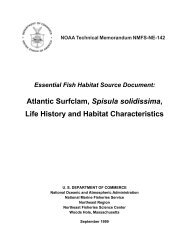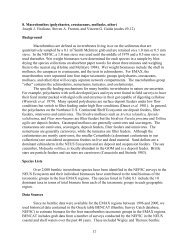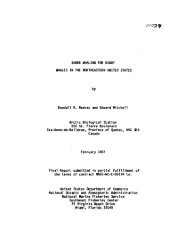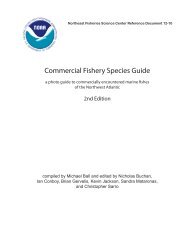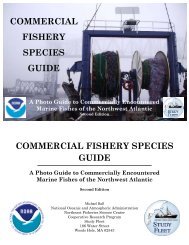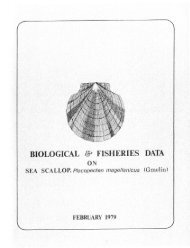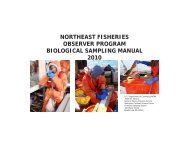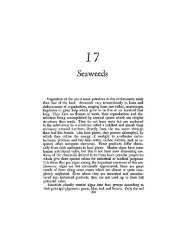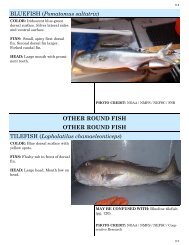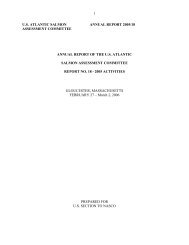Scup, Stenotomus chrysops, Life History and Habitat Characteristics
Scup, Stenotomus chrysops, Life History and Habitat Characteristics
Scup, Stenotomus chrysops, Life History and Habitat Characteristics
You also want an ePaper? Increase the reach of your titles
YUMPU automatically turns print PDFs into web optimized ePapers that Google loves.
Long Isl<strong>and</strong> from July through October. Gottschall et al.<br />
(in review) reported that YOY scup (approximately 4 cm<br />
FL) were first collected in Long Isl<strong>and</strong> Sound in August<br />
<strong>and</strong> became numerically dominant in the catch by<br />
September; 1 year old juveniles were collected in April.<br />
However, other surveys of Long Isl<strong>and</strong> estuaries or surf<br />
zones did not support these findings (Schaefer 1967;<br />
Briggs 1975b).<br />
The occurrence of juveniles in coastal bays <strong>and</strong><br />
estuaries south of Long Isl<strong>and</strong> is temporally <strong>and</strong> spatially<br />
variable. In Raritan Bay, juveniles were abundant in<br />
spring <strong>and</strong> summer; a few were collected in the fall <strong>and</strong><br />
were not collected in winter (Figure 17). While juveniles<br />
occur in the larger bays; e.g., Raritan <strong>and</strong> Delaware Bays<br />
(de Sylva et al. 1962; Werme et al. 1983), they seldom<br />
occur in smaller coastal lagoons such as Barnegat Bay<br />
(New Jersey), tributaries of the Hudson-Raritan estuary,<br />
or the ocean surf zone (Marcellus 1972; Howells <strong>and</strong><br />
Brundage III 1977; Vouglitois 1983; Wilk et al. 1997; D.<br />
Clark, personal communication).<br />
Varying numbers have been collected in New Jersey<br />
estuaries south of Barnegat Bay; i.e. within Hereford Inlet<br />
(Allen et al. 1978). Although formerly relatively<br />
abundant, juvenile scup have not occurred in large<br />
numbers in vegetated sites in lower Chesapeake Bay<br />
(Orth <strong>and</strong> Heck 1980; MAFMC 1996). However, in fall<br />
they are still collected in relatively large numbers by the<br />
NEFSC trawl surveys at the mouth of the bay (Figure 12).<br />
While juveniles do not occur to any great extent in seaside<br />
bays of Maryl<strong>and</strong> <strong>and</strong> Virginia (Arve 1960; Schwartz<br />
1961, 1964), Richards <strong>and</strong> Castagna (1970) did find them<br />
in their survey of Virginia’s seaside bays.<br />
The NEFSC groundfish surveys (1963-1997) mostly<br />
post-date the last period of high scup abundance,<br />
approximately 1950-1965 (Northeast Fisheries Science<br />
Center 1997). The NEFSC bottom trawl survey results<br />
for 1963-1964 (not shown) indicated that juveniles were<br />
widespread <strong>and</strong> distribution was similar to the present.<br />
The only apparent change in this general coastal<br />
distribution pattern was in the late 1960s (during the<br />
period of relatively low abundance) when the largest<br />
collections of juveniles were clustered off southern New<br />
Engl<strong>and</strong>, Virginia, <strong>and</strong> North Carolina. This distribution<br />
pattern raised the question of whether there were two<br />
stocks in the Middle Atlantic Bight (Hamer 1970).<br />
ADULTS<br />
Adults have been reported as far north as the Bay of<br />
Fundy, southern Nova Scotia, <strong>and</strong> Sable Isl<strong>and</strong> Bank (east<br />
of Nova Scotia) as summer visitors (Scott <strong>and</strong> Scott 1988)<br />
<strong>and</strong> at least as far south as Cape Hatteras. As part of a<br />
temperate, migrant guild, scup have even been collected<br />
occasionally on the southern Gr<strong>and</strong> Banks (Brown et al.<br />
1996).<br />
<strong>Scup</strong> occur primarily in the Middle Atlantic Bight.<br />
Page 7<br />
They migrate from offshore winter habitats into coastal<br />
waters from Chesapeake Bay to southern New Engl<strong>and</strong><br />
where they reside from spring to fall (Bigelow <strong>and</strong><br />
Schroeder 1953; Richards 1963a; Scott <strong>and</strong> Scott 1988;<br />
Morse 1978; Chang 1990). These migration patterns are<br />
reflected in the results of the NEFSC bottom trawl<br />
surveys (Figure 12) <strong>and</strong> in the Massachusetts inshore<br />
survey (Figure 13). During warm months, larger scup<br />
occur in or near the mouths of larger bays, such as<br />
Narragansett Bay (Figures 14, 15) <strong>and</strong> Long Isl<strong>and</strong> Sound<br />
(Figure 16), <strong>and</strong> along the coast within the 38 m contour<br />
(Morse 1978).<br />
Distribution <strong>and</strong> abundance of adult scup off New<br />
Engl<strong>and</strong> is temperature dependent (Mayo 1982; Gabriel<br />
1992). Smaller fish are found in more saline (> 15 ppt)<br />
shallow bays <strong>and</strong> parts of estuaries including the Hudson-<br />
Raritan estuary <strong>and</strong> Hereford Inlet (New Jersey) (Figures<br />
6, 17; Allen et al. 1978; Morse 1978; Werme et al. 1983;<br />
Wilk et al. 1997). However, they may not be abundant in<br />
all bays; e.g., they have not been reported in Barnegat<br />
Bay (Marcellus 1972; Vouglitois 1983; Tatham et al.<br />
1984), Maryl<strong>and</strong> bays (MAFMC 1996), or in New York<br />
Harbor (Stoecker et al. 1992; Will <strong>and</strong> Houston 1992).<br />
Adult scup usually arrive offshore in December <strong>and</strong><br />
winter in deeper water from Nantucket Shoals to Cape<br />
Hatteras to depths of about 240 m (Figures 5 <strong>and</strong> 12;<br />
Pearson 1932; Neville <strong>and</strong> Talbot 1964; Morse 1978).<br />
<strong>Scup</strong> density <strong>and</strong> distribution during the winter are related<br />
to the location of the 7 o C bottom isotherm, their lower<br />
preferred limit (Neville <strong>and</strong> Talbot 1964). Nesbit <strong>and</strong><br />
Neville (1935) indicated that this b<strong>and</strong> of warmer, outer<br />
continental shelf water is influenced mainly by the Gulf<br />
Stream just off the shelf. During warm winters, scup can<br />
be found across most of the continental shelf south of<br />
New Jersey (Nesbit <strong>and</strong> Neville 1935). As coastal waters<br />
warm above the 7 o C threshold in spring, scup return<br />
inshore <strong>and</strong> to the north.<br />
STATUS OF THE STOCKS<br />
Commercial l<strong>and</strong>ings of scup in the Middle Atlantic<br />
Bight have declined substantially since peak l<strong>and</strong>ings in<br />
the 1950s <strong>and</strong> early 1960s; although there was a minor<br />
peak in l<strong>and</strong>ings in the early 1980s (Figure 18; Northeast<br />
Fisheries Science Center 1997). Recreational l<strong>and</strong>ings<br />
have also declined (MAFMC 1996).<br />
Groundfish surveys by the NEFSC indicated cycles<br />
in abundance of scup of about 3-4 years <strong>and</strong> an overall<br />
decline since the 1950-1960s (Figure 18; Gabriel 1998).<br />
Currently, the stock is composed primarily of fish < 3<br />
years old <strong>and</strong> the age distribution is truncated (MAFMC<br />
1996). The abundance of scup eggs off southern New<br />
Engl<strong>and</strong> has been low recently (Gray 1990; Able <strong>and</strong><br />
Fahay 1998). According to Jeffries <strong>and</strong> Terceiro (1985),<br />
slightly warmer average summer temperatures (+1°C) in<br />
coastal waters off southern New Engl<strong>and</strong> are related to an




